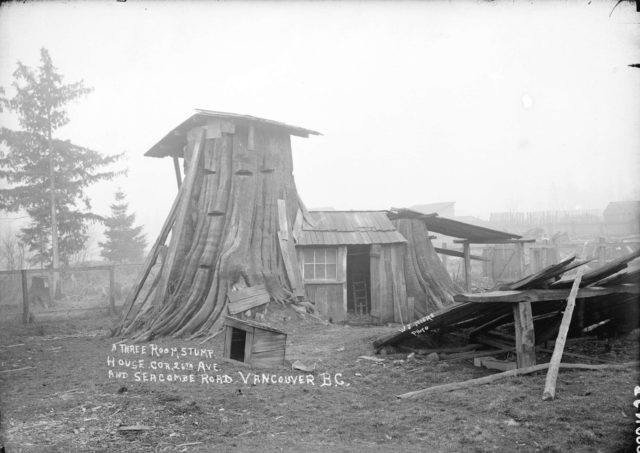Stump Houses Really Were a Thing

The Pacific Northwest saw some of the most significant number of settlers looking for a new life all through the nineteenth century, however, the journey from moving towards the Northwest to a peaceful life in the serene woodlands wasn’t an easy endeavour.
The settlers had to instantly confront the dark dense woodlands and at the same time had to fight against (not literally but on an economical level) with big logging companies to find enough timber to build their houses, barns, and other structures.
Mostly what was left behind was often a scarred landscape and scrap wood, most of this wood was in the form of stumps that big companies deemed useless.




These stumps were tall, some as high as ten feet, and the settlers had to adapt to using these off casts so that they could have shelter for themselves and their families.
The first impression of the pioneers who headed to these woodlands, was one of great surprise to find such vast lands with great farming and development potential.
However, after the initial awe had fizzled out, the settlers had to confront the reality of clearing the land of the towering stumps. These homesteads proved to be rather more challenging then it initially seemed.
These stumps would either have to be burnt or rooted out, this was the only way to make the space for orchards and crops to keep the livestock and the families of the pioneers sustained.
The enormity of the task first kept the settlers at bay, who resorted to simply living alongside these stump infested lands, some even arranged musical festivals and dances around these stumps.
However slowly but surely some people started seeing a way around the problem, and soon people started building roofs over these naturally tall and soundly rooted pillars.




A roof on the top of the stumps and a gate or a window meant a quick makeshift shed where farmers kept their chicken, and other livestock perfectly safe from bear, bobcats, and racoons.
For a long time, tree stumps served as temporary shelter for travellers and migrants who had to hide from treacherous weather or even dangerous predators, however using these stumps to build a cabin or house worthy of living in was a whole new matter.
As early as 1847 the records show a pioneering family known as McAllister’s, who had initially settled in the south of Tumwater on Bush Prairie decided to build a proper house out of stumps when they moved to Medicine Creek area near Nisqually.
After living in their stump house and then building a proper house, the McAllister family changed their trees tump house into a barn that served them very well.
Another story which emerged later in the century relates to William D. McDonald in 1892 who took the most noteworthy step by opening first US Post Office in a large roofed structure built out of stumps.
Another Article From Us:Mammoth Graveyard Being Looted by Black Market Hunters
The Post Office was located in a remote northern region of the Olympic Peninsula, some ten miles southwest of Port Angeles on the eastern edge of the Elwha River.
